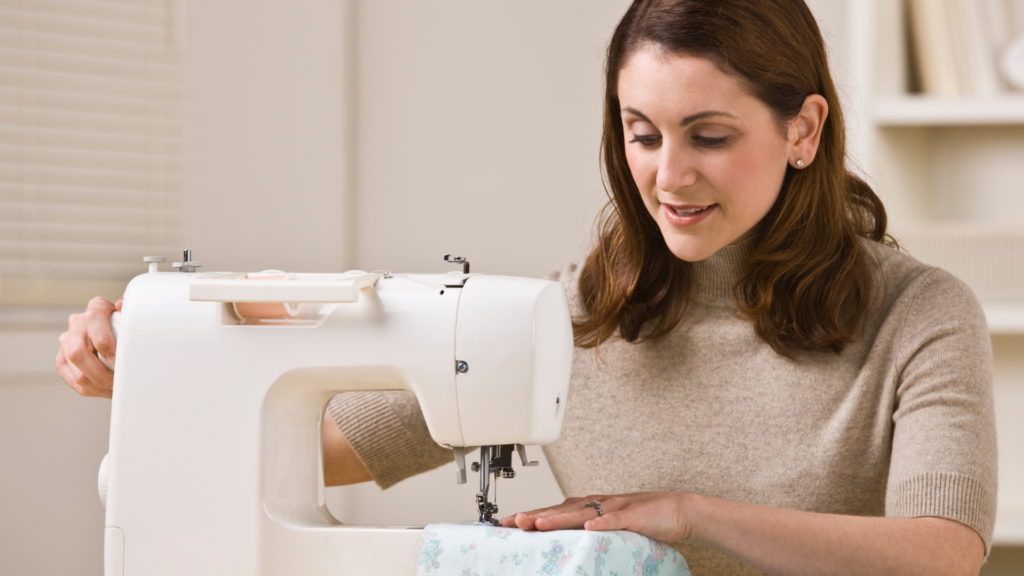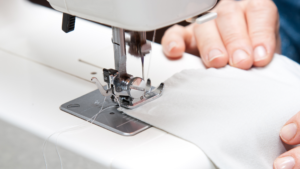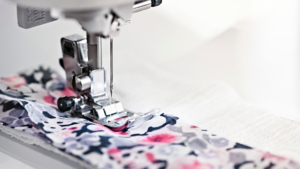Last Updated on June 1, 2022
This guide will show you everything you need to learn about double stitch needles, which is very important especially for beginners.
The popular twin needle or double needle is composed of two needles connected by a single bar that will create two lines of stitching on the front and a zigzag stitch on the back commonly used for hemming knit clothing.
Double stitch needle sizes
Let’s start with the sizes.
The sizes of double stitch sewing machine needles which are often used include 1.6 mm, 2.0 mm, 3.0 mm, 4.0 mm, and 6.0 mm. Its size refers to the spacing seen between needles in millimeters. The size 6.0mm may be too large for some machines.
If your machine’s largest zigzag stitch is 4.0mm, you should never consider using 6.0mm because the throat plate hole is too small for the additional twin needle. Moreover, its bobbin thread snags both top threads, producing a zigzag pattern on the underside of the cloth you’re stitching.
Generally, the size of the needle is indicated by two digits. The two values represent the distance between the needle tips and the needle size individually. So, a size 80/4.0mm needle, for example, is two sizes 80 needles placed 4 mm apart for your reference.

Six types of double stitch needles
- Universal twin needles – They are fantastic, all-purpose needles. They are utilized for the majority of woven textiles as well as some sturdy knits. The universal needles have a slightly rounded tip that allows them to easily glide through the weaving of knits while keeping adequate sharpness for woven materials.
- Stretch double stitch needles – These twin needles for stretchy knit fabric are typically smaller (size 75) and come in two varieties: 2.5mm or 4mm inter-needle distance. In addition, it has a more rounded tip than the universal double stitch needle.
- Double stitch needle embroidery – These needles have a larger groove and eye, making them ideal for ornamental stitching. In addition, it works at a faster rate than normal stitching. Also, it has a specially-coated eye which enables flawless thread flow at greater rates.
- Double stitch metallic needles; these metallic twin needles are distinguished from the others by their larger specially coated eye of 2 mm and a wide groove in the shafts that avoids thread breakage.
- Denim needles – Similar to a twin universal needle. The denim twin needle has a sharp, powerful tip that will penetrate thick materials. In addition, this kind of point needle penetrates several layers of dense material more quickly. Furthermore, the diameter of a twin needle for usage on jeans is 100. Stitching denim cloth will be a breeze with such a thick and sharp needle. I can perfectly say that this is ideal for stitching woven materials as well.
- Double stitch needle hemstitch. It is simply a type of ornamental stitching that is used on tightly woven textiles.
How will you fit a double stitch needle into your sewing machine?
First things first, you need to move the handwheel to the right to raise the needle to its top level. Then, you have to drop the presser foot or perhaps remove it entirely.
Then, while holding the normal needle only if present, loosen the fastening screw and take the needle from the needle holder, place the twin needle with its flat side facing you in place of the previous one until the needle contacts the stopper. Then, again, tighten the fastening screw while holding the needle in place.
Please remember that two spools of thread are required when using a double stitch sewing machine needle, and the threads on both spools must be of the same quality to achieve a clean and consistent stitch.
On the other hand, contemporary sewing machines feature two spool pins, such as Janome, Juki, and Brother sewing machines.
But, you have to learn that every sewing machine is designed differently, and as a result, each has a unique design, selections, and a lot to offer.

How to thread the needles
After placing the needle in your sewing machine, you must then understand how to thread them.
First is threading the bobbin; in this section, you should thread the bobbin as normal. You do not have to follow certain instructions here.
Second is the first reel threading; you may now thread the sewing machine properly with the first reel. Next, insert the thread through the left needle.
The third and last is the second reel threading; you should pass the second reel of threads into the machine, normally going to the twin needle’s right side.
Here’s how you will use your double stitch needle in sewing
You may place pins beneath your hemline on the right side where you will be stitching. Set foot in place and get ready to stitch. It would help determine the distance to stitch from the edges by feeling the edge with your fingertips while you sew. Your stitching should be close to the edge but not go over it.
You will usually use a straight pattern to stitch hems, but you may also try zigzag or other ornamental stitches as you wish.
And since we’re done with the types, sizes, and how to install, thread, and use the needle. Now, let’s continue by giving you…

Tips for an easy double stitch sewing journey
Tunneling tendency is a typical issue with double stitch needle stitching. Here’s what you should do to prevent it from happening in the future.
You may change the needle tension of your machine’s stitch length and start on scraps of cloth until you are pleased with the outcomes. Do not be afraid to try until you get your desired result.
And if you still have trouble with tunneling, a stabilizer can assist.
As you stitch, just place a wash-away or tearaway stabilizer under the cloth and remove it when completed. If you are using a tearaway stabilizer, make sure not to strain the cloth as you remove it.
Then, you may also solve this issue by putting a cut of hemming tape underneath the hem to give weight and thickness. But, if you do not have any hemming tapes on hand, you may use 1cm strips of double-sided interfacing.
Another issue that you may encounter is a fabric that is being stretched out.
You must try feeding the top layer with an awl. It is a popular and efficient approach, using rhythmic motion to gently nudge the top surface of the fabric more to the presser foot with an awl or another long and pointy object while sewing over the fabric. It takes some skill because you’ll have to synchronize multiple things simultaneously, but the result will surely amaze you.
Another one is the use of your walking foot. A walking foot accomplishes the same objective as the awl technique because it feeds the top and lower layers more uniformly than a normal presser foot.
Then, a stabilizer may also help avoid this issue; despite how stretchy your fabric can be, you’ll notice how smooth it lies with a stabilizer, completely flat with no wobbling areas.
The next potential issue is the popping seams. But, again, it is just a simple repair. You only have to simply reduce the stitch length to gain extra elasticity from the twin-needle stitching.
Finally, the last possible issue you may encounter while using a double stitch needle is skipped stitches. Admit it, it isn’t very pleasant, yet it is all too frequent. Fortunately, there are numerous solutions that you can try to solve this problem.
You may use a twin-needle stretch knit ballpoint. The unique ballpoint tip will better penetrate knit materials and decrease the possibility of skipped stitches. It also makes uneven surfaces flat.
Skipped stitches are most common whenever the presser foot is raised when stitching over thick seams. You can try these methods for your convenience.
- Make a tiny snip in the seam allowance and slide it in the other way. It will bring the surface back into alignment.
- Next, gently pound on the seams with a rubber mallet to eliminate the volume and flatten the seams. It is ideal for regions where many seams meet, and cutting alone will not be enough.
- Place the tool beneath the presser foot, a hump-jumper, to remain horizontal even while stitching over uneven surfaces.
Some Final Words
We have provided you with this comprehensive guide about using a twin or double needle stitch and possible issues you might encounter using a double-needle machine for your sewing projects.
First, it is pretty simple once you have prepared the sewing machine for your double threads. Second, when you have tried this useful double needle on your hems, this might actually become your favorite. And, finally, with these, we hope that you’re equipped with the knowledge you will need along your sewing journey.
Happy sewing!






